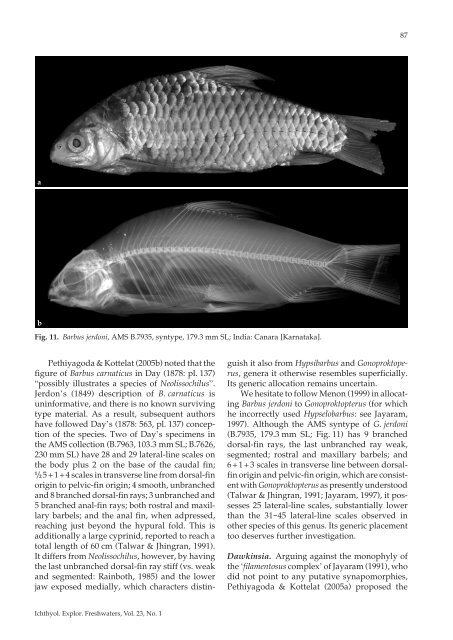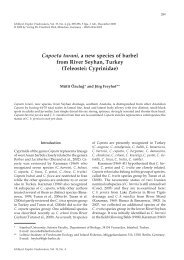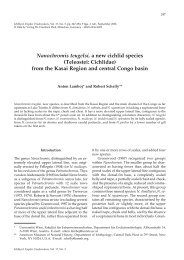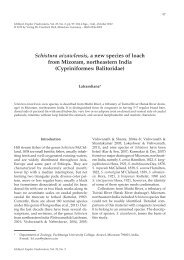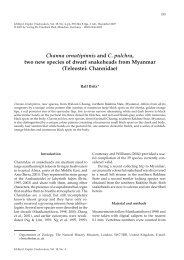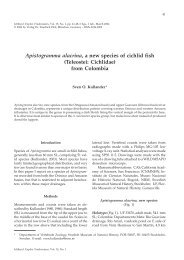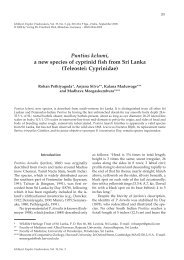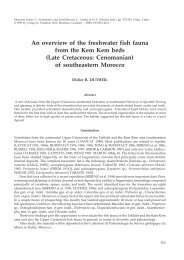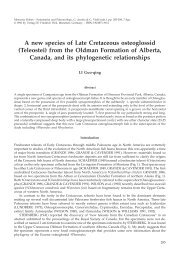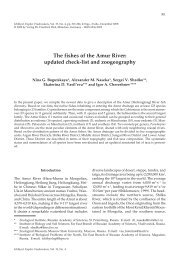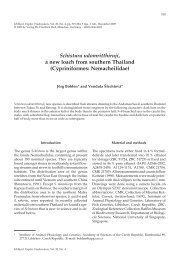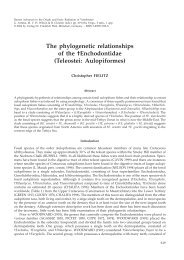A synopsis of the South Asian fishes referred to Puntius - Verlag Dr ...
A synopsis of the South Asian fishes referred to Puntius - Verlag Dr ...
A synopsis of the South Asian fishes referred to Puntius - Verlag Dr ...
Create successful ePaper yourself
Turn your PDF publications into a flip-book with our unique Google optimized e-Paper software.
a<br />
b<br />
Fig. 11. Barbus jerdoni, AMS B.7935, syntype, 179.3 mm SL; India: Canara [Karnataka].<br />
Pethiyagoda & Kottelat (2005b) noted that <strong>the</strong><br />
figure <strong>of</strong> Barbus carnaticus in Day (1878: pl. 137)<br />
“possibly illustrates a species <strong>of</strong> Neolissochilus”.<br />
Jerdon’s (1849) description <strong>of</strong> B. carnaticus is<br />
uninformative, and <strong>the</strong>re is no known surviving<br />
type material. As a result, subsequent authors<br />
have followed Day’s (1878: 563, pl. 137) conception<br />
<strong>of</strong> <strong>the</strong> species. Two <strong>of</strong> Day’s specimens in<br />
<strong>the</strong> AMS collection (B.7963, 103.3 mm SL; B.7626,<br />
230 mm SL) have 28 and 29 lateral-line scales on<br />
<strong>the</strong> body plus 2 on <strong>the</strong> base <strong>of</strong> <strong>the</strong> caudal fin;<br />
1 /2 5 + 1 + 4 scales in transverse line from dorsal-fin<br />
origin <strong>to</strong> pelvic-fin origin; 4 smooth, unbranched<br />
and 8 branched dorsal-fin rays; 3 unbranched and<br />
5 branched anal-fin rays; both rostral and maxillary<br />
barbels; and <strong>the</strong> anal fin, when adpressed,<br />
reaching just beyond <strong>the</strong> hypural fold. This is<br />
additionally a large cyprinid, reported <strong>to</strong> reach a<br />
<strong>to</strong>tal length <strong>of</strong> 60 cm (Talwar & Jhingran, 1991).<br />
It differs from Neolissochilus, however, by having<br />
<strong>the</strong> last unbranched dorsal-fin ray stiff (vs. weak<br />
and segmented: Rainboth, 1985) and <strong>the</strong> lower<br />
jaw exposed medially, which characters distin-<br />
Ichthyol. Explor. Freshwaters, Vol. 23, No. 1<br />
87<br />
guish it also from Hypsibarbus and Gonoprok<strong>to</strong>perus,<br />
genera it o<strong>the</strong>rwise resembles superficially.<br />
Its generic allocation remains uncertain.<br />
We hesitate <strong>to</strong> follow Menon (1999) in allocating<br />
Barbus jerdoni <strong>to</strong> Gonoprok<strong>to</strong>pterus (for which<br />
he incorrectly used Hypselobarbus: see Jayaram,<br />
1997). Although <strong>the</strong> AMS syntype <strong>of</strong> G. jerdoni<br />
(B.7935, 179.3 mm SL; Fig. 11) has 9 branched<br />
dorsal-fin rays, <strong>the</strong> last unbranched ray weak,<br />
segmented; rostral and maxillary barbels; and<br />
6 + 1 + 3 scales in transverse line between dorsalfin<br />
origin and pelvic-fin origin, which are consistent<br />
with Gonoprok<strong>to</strong>pterus as presently unders<strong>to</strong>od<br />
(Talwar & Jhingran, 1991; Jayaram, 1997), it possesses<br />
25 lateral-line scales, substantially lower<br />
than <strong>the</strong> 31-45 lateral-line scales observed in<br />
o<strong>the</strong>r species <strong>of</strong> this genus. Its generic placement<br />
<strong>to</strong>o deserves fur<strong>the</strong>r investigation.<br />
Dawkinsia. Arguing against <strong>the</strong> monophyly <strong>of</strong><br />
<strong>the</strong> ‘filamen<strong>to</strong>sus complex’ <strong>of</strong> Jayaram (1991), who<br />
did not point <strong>to</strong> any putative synapomorphies,<br />
Pethiyagoda & Kottelat (2005a) proposed <strong>the</strong>


